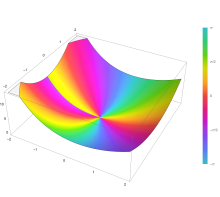Whittaker function

In mathematics, a Whittaker function is a special solution of Whittaker's equation, a modified form of the confluent hypergeometric equation introduced by Whittaker (1903) to make the formulas involving the solutions more symmetric. More generally, Jacquet (1966, 1967) introduced Whittaker functions of reductive groups over local fields, where the functions studied by Whittaker are essentially the case where the local field is the real numbers and the group is SL2(R).
Whittaker's equation is
It has a regular singular point at 0 and an irregular singular point at ∞. Two solutions are given by the Whittaker functions Mκ,μ(z), Wκ,μ(z), defined in terms of Kummer's confluent hypergeometric functions M and U by
The Whittaker function is the same as those with opposite values of μ, in other words considered as a function of μ at fixed κ and z it is even functions. When κ and z are real, the functions give real values for real and imaginary values of μ. These functions of μ play a role in so-called Kummer spaces.[1]
Whittaker functions appear as coefficients of certain representations of the group SL2(R), called Whittaker models.
References[edit]
- ^ Louis de Branges (1968). Hilbert spaces of entire functions. Prentice-Hall. ASIN B0006BUXNM. Sections 55-57.
- Abramowitz, Milton; Stegun, Irene Ann, eds. (1983) [June 1964]. "Chapter 13". Handbook of Mathematical Functions with Formulas, Graphs, and Mathematical Tables. Applied Mathematics Series. Vol. 55 (Ninth reprint with additional corrections of tenth original printing with corrections (December 1972); first ed.). Washington D.C.; New York: United States Department of Commerce, National Bureau of Standards; Dover Publications. pp. 504, 537. ISBN 978-0-486-61272-0. LCCN 64-60036. MR 0167642. LCCN 65-12253. See also chapter 14.
- Bateman, Harry (1953), Higher transcendental functions (PDF), vol. 1, McGraw-Hill, archived from the original (PDF) on 2011-08-11, retrieved 2011-07-30.
- Brychkov, Yu.A.; Prudnikov, A.P. (2001) [1994], "Whittaker function", Encyclopedia of Mathematics, EMS Press.
- Daalhuis, Adri B. Olde (2010), "Whittaker function", in Olver, Frank W. J.; Lozier, Daniel M.; Boisvert, Ronald F.; Clark, Charles W. (eds.), NIST Handbook of Mathematical Functions, Cambridge University Press, ISBN 978-0-521-19225-5, MR 2723248.
- Jacquet, Hervé (1967), "Fonctions de Whittaker associées aux groupes de Chevalley", Bulletin de la Société Mathématique de France, 95: 243–309, doi:10.24033/bsmf.1654, ISSN 0037-9484, MR 0271275
- Rozov, N.Kh. (2001) [1994], "Whittaker equation", Encyclopedia of Mathematics, EMS Press.
- Slater, Lucy Joan (1960), Confluent hypergeometric functions, Cambridge University Press, MR 0107026.
- Whittaker, Edmund T. (1903), "An expression of certain known functions as generalized hypergeometric functions", Bulletin of the A.M.S., 10 (3), Providence, R.I.: American Mathematical Society: 125–134, doi:10.1090/S0002-9904-1903-01077-5
Further reading[edit]
- Hatamzadeh-Varmazyar, Saeed; Masouri, Zahra (2012-11-01). "A fast numerical method for analysis of one- and two-dimensional electromagnetic scattering using a set of cardinal functions". Engineering Analysis with Boundary Elements. 36 (11): 1631–1639. doi:10.1016/j.enganabound.2012.04.014. ISSN 0955-7997.
- Gerasimov, A. A.; Lebedev, Dmitrii R.; Oblezin, Sergei V. (2012). "New integral representations of Whittaker functions for classical Lie groups". Russian Mathematical Surveys. 67 (1): 1–92. arXiv:0705.2886. Bibcode:2012RuMaS..67....1G. doi:10.1070/RM2012v067n01ABEH004776. ISSN 0036-0279.
- Baudoin, Fabrice; O’Connell, Neil (2011). "Exponential functionals of brownian motion and class-one Whittaker functions". Annales de l'Institut Henri Poincaré, Probabilités et Statistiques. 47 (4): 1096–1120. arXiv:0809.2506. Bibcode:2011AIHPB..47.1096B. doi:10.1214/10-AIHP401. S2CID 113388.
- McKee, Mark (April 2009). "An Infinite Order Whittaker Function". Canadian Journal of Mathematics. 61 (2): 373–381. doi:10.4153/CJM-2009-019-x. ISSN 0008-414X. S2CID 55587239.
- Mathai, A. M.; Pederzoli, Giorgio (1997-03-01). "Some properties of matrix-variate Laplace transforms and matrix-variate Whittaker functions". Linear Algebra and Its Applications. 253 (1): 209–226. doi:10.1016/0024-3795(95)00705-9. ISSN 0024-3795.
- Whittaker, J. M. (May 1927). "On the Cardinal Function of Interpolation Theory". Proceedings of the Edinburgh Mathematical Society. 1 (1): 41–46. doi:10.1017/S0013091500007318. ISSN 1464-3839.
- Cherednik, Ivan (2009). "Whittaker Limits of Difference Spherical Functions". International Mathematics Research Notices. 2009 (20): 3793–3842. arXiv:0807.2155. doi:10.1093/imrn/rnp065. ISSN 1687-0247. S2CID 6253357.
- Slater, L. J. (October 1954). "Expansions of generalized Whittaker functions". Mathematical Proceedings of the Cambridge Philosophical Society. 50 (4): 628–631. Bibcode:1954PCPS...50..628S. doi:10.1017/S0305004100029765. ISSN 1469-8064. S2CID 122348447.
- Etingof, Pavel (1999-01-12). "Whittaker functions on quantum groups and q-deformed Toda operators". arXiv:math/9901053.
- McNamara, Peter J. (2011-01-15). "Metaplectic Whittaker functions and crystal bases". Duke Mathematical Journal. 156 (1): 1–31. arXiv:0907.2675. doi:10.1215/00127094-2010-064. ISSN 0012-7094. S2CID 979197.
- Mathai, A. M.; Pederzoli, Giorgio (1998-01-15). "A whittaker function of matrix argument". Linear Algebra and Its Applications. 269 (1): 91–103. doi:10.1016/S0024-3795(97)00059-1. ISSN 0024-3795.
- Frenkel, E.; Gaitsgory, D.; Kazhdan, D.; Vilonen, K. (1998). "Geometric realization of Whittaker functions and the Langlands conjecture". Journal of the American Mathematical Society. 11 (2): 451–484. arXiv:alg-geom/9703022. doi:10.1090/S0894-0347-98-00260-4. ISSN 0894-0347. S2CID 13221400.




